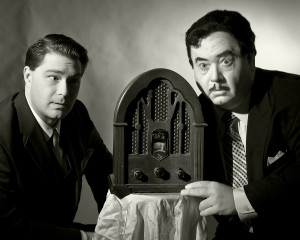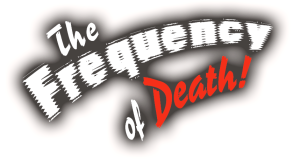 Radio drama is nearly 90 years old, reaching its peak during the middle to late 1940s. Before the 1920s, formal radio programs were unknown. Most broadcasts were one-time events consisting mainly of talk and music. Broadcast hours were irregular, usually four or five hours a day, and the only regularly scheduled broadcasts were weather reports. Once in a while, musical events such as symphonies and operas were broadcast from the locations where they were being performed. Occasionally stage plays were broadcast from the theatre, and sporting events were broadcast with play-by-play announcing.
Radio drama is nearly 90 years old, reaching its peak during the middle to late 1940s. Before the 1920s, formal radio programs were unknown. Most broadcasts were one-time events consisting mainly of talk and music. Broadcast hours were irregular, usually four or five hours a day, and the only regularly scheduled broadcasts were weather reports. Once in a while, musical events such as symphonies and operas were broadcast from the locations where they were being performed. Occasionally stage plays were broadcast from the theatre, and sporting events were broadcast with play-by-play announcing.
In the mid 1920s, larger stations began to develop programs using announcers or narrators. These programs used definite openings and closings and were built around specific program ideas. Radio drama was born in 1927, when networks began adapting short stories, and even writing original scripts, for broadcast.
During the last part of the 1920s, many one-hour, sponsored network programs started. Musical variety and concert music programs were the most popular forms during this period. Some of these network variety programs used a different format each week-a musical program one week, a talk or a debate the next week, and perhaps a dramatization the third week. During this period, the network schedules included two or three minstrel variety programs and a comedy variety program using a series of several comedy acts in a half hour. Song-and-patter teams, usually two person teams that used talk between songs, became popular during this period. Later on patter-only comedy acts appeared. The Amos ‘n’ Andy show was one of the first to use this format. At first, Amos ‘n’ Andy presented patter five nights a week for fifteen minutes each night.
During the 1930-31 season, the comedy dramatic form became an important part of radio programming, when Amos ‘n’ Andy adopted a story line. Amos ‘n’ Andy was so popular that the program survived even into the TV era.
In the early 1930s, national advertisers recognized the potential for radio advertising and became willing to buy air-time and sponsor programs. As this happened, networks competed for their share. The result was the development of many new program forms. Among the new program types were: vaudeville variety programs, dramatized news programs, programs built around a comedian, advice/interview programs, amateur contests, town meetings, daily network news programs, daytime “soap opera” serialized drama, after school juvenile serialized adventure drama, and hillbilly variety programs. As network daytime serials became popular, stations developed daytime schedules.
In order to survive the depression years, many local stations scheduled commercial religious programs, programs with cultural appeal (country music for instance), and astrology programs that included strong appeals for donations to keep the show on the air. During this time, local news programs were usually one fifteen-minute broadcast per day, getting their news from daily newspapers.
In the early 1940s, radio programs reflected America’s involvement in World War II. As the number of news and human interest programs grew, other types of programming (evening variety, musical, quiz, and audience participation programs) shrunk. During this time, evening dramatic programs exploded in number.
As a result of the country’s involvement in the war, the number of hours per week devoted to news broadcasts nearly doubled. It was probably this abundance of war news that propelled the spectacular growth of evening dramatic programs. As listeners grew tired of war talk, they turned to other programs for escape. The forms that offered the most escape were comedy-variety, comedy drama, and thriller drama. As a matter of fact, one of the dramatic series created during this period was entitled Escape. During the 1944-45 season, the networks scheduled 8 hours of comedy variety, 8 hours of comedy drama programs, and 14 hours of thriller drama each week. By the end of this period, networks offered 47 hours a week of dramatic programs during the evening and on Sunday. Thriller drama programs accounted for roughly half of these each week.
In the early years of television, not enough homes had a TV receiver and national sponsors were hard to find, therefore, production costs had to be controlled. Nowadays with television in practically every home, it is easier for statistics (source here) to be drawn about who is watching television and what they are watching to help companies see what they should move over and advertise as well as when. Back then it was too expensive to create new forms and take a chance on an unknown show, so the forms that existed at the time on radio were moved directly to television. In fact, many of the successful radio series went directly to television. Gunsmoke, an extremely successful western drama, was one among several that could be heard on radio and seen on TV. Suspense, radio’s longest-running thriller series, was another.
Eventually, with the advent and expansion of television, radio drama faded into history. The occasional comedic or dramatic broadcast pops up, generally on National Public Radio, but for the most part, the art form has become obsolete.
— Adapted from “Theatre of the Mind” by Balance Publishing Company
 Experience the magic of RadioVizion™ in The Frequency of Death! running March 25 through April 3, 2016 at the Bath House Cultural Center, with a special encore performance April 4, 2016 at the Eisemann Center in Richardson.
Experience the magic of RadioVizion™ in The Frequency of Death! running March 25 through April 3, 2016 at the Bath House Cultural Center, with a special encore performance April 4, 2016 at the Eisemann Center in Richardson.
